Author: Monchi | Editor: Monchi
1. Bitcoin Market
From May 3 to May 9, 2025, the specific trend of Bitcoin is as follows:
May 3 : On that day, Bitcoin showed an overall volatile downward trend, and the price began to adjust from the high of $97,754. The bulls and bears engaged in a fierce game around the key support level. The intraday price once fell back to around $97,000, but failed to gain effective support, and then further fell to the low of the day at $95,986. Near the end of the trading day, the market rebounded and closed at $96,523. The short-term stop-loss signal began to appear, and the bearish momentum slowed down.
May 4 : Bitcoin continued its weak trend the day before, and fluctuated and fell throughout the day. After a brief rebound, it continued to weaken, hitting a low of $95,328. It closed slightly higher but was weak overall, indicating that bullish confidence was still insufficient.
May 5 : The market fluctuated violently, with a clear "cliff-like" decline during the day. The price quickly fell from the morning high of $95,734 to a low of $93,612. Although it rebounded to $94,752 during the session, the overall trend remained weak, and it fluctuated and fell back to $93,696 at the end of the session, indicating that the short-selling pressure has significantly increased.
May 6 : Bitcoin continued the violent fluctuation pattern of the previous day, and was in a wide range of fluctuations. It tried to rebound to $94,816 and $95,114 several times, but failed to stabilize effectively, and then bottomed out again at a low of $93,438. After that, market sentiment gradually stabilized, and the price rebounded rapidly, closing at $94,703 during the day, initially forming a short-term reversal signal.
May 7 : Bitcoin continued its rebound momentum from the previous day, rising to $95,100 in the morning and then rising rapidly, reaching an intraday high of $97,583. Although it then fell back to $96,336, it rose again to $97,379 in the late trading. Overall, bullish sentiment gradually took the lead, and market trading activity increased significantly.
May 8 : Bitcoin experienced a brief correction after opening, dropping to $95,866. Subsequently, the bulls quickly strengthened, and the price rebounded strongly and broke through the previous high, reaching $97,317. The rise further accelerated, reaching an intraday high of $99,819, approaching the key psychological level of $100,000. Market sentiment turned significantly bullish, and the price continued to rise under the dominance of bulls. After a brief correction, it rose again and finally successfully broke through the integer level of $100,000. The increase throughout the day was significant and the trend was strong.
May 9 : The upward momentum continued, and Bitcoin rose to $101,506 in the early trading. Then there was a slight technical adjustment, but it quickly resumed its upward trend and broke through the new high in a straight line, reaching a high of $103,756. The market then entered a period of shock consolidation, and the price fell back to around $102,850 and traded sideways. As of writing, Bitcoin is temporarily reported at $102,945, and it remains in a high range overall, and it is still strong in the short term.
Summarize
This week, the Bitcoin market as a whole experienced a process of "first decline and then rise". In the first half of the week, due to insufficient market confidence and external macro factors, the price rebounded and once fell below the support level of $94,000. However, since May 6, market sentiment has gradually recovered, and bulls have driven a sharp rebound in prices. Combined with the stimulation of good news, Bitcoin has continuously broken through multiple technical resistance levels, strongly breaking through the $100,000 mark, and set a new high of $103,756 on May 9, showing the strong resilience and optimistic expectations of the market under the dominance of bulls. From a technical perspective, the bullish trend has gradually been established. In the short term, we need to pay attention to the support of changes in trading volume and the sustainability of sentiment for the future market.
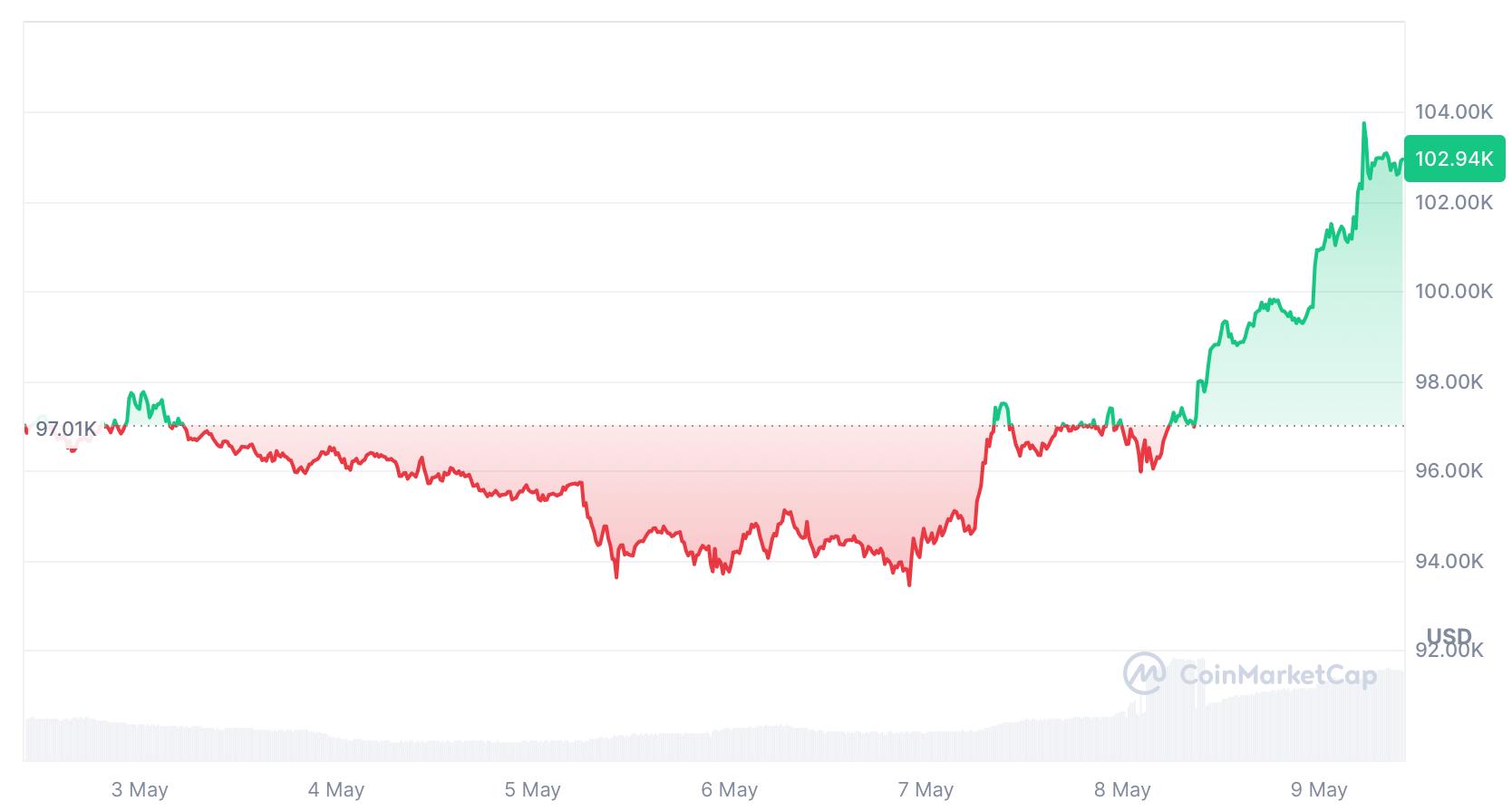
Bitcoin price trend (2025/05/03-2025/05/09)
2. Market dynamics and macro background
Fund Flows
1. Market dominance: Bitcoin's market share continues to rise, while altcoins are relatively losing ground
In the past week, Bitcoin's market share (BTC Dominance, BTC.D) has risen strongly, setting new highs since this bull market many times, reflecting that funds continue to flow back to Bitcoin during the market adjustment phase: On May 4, according to CoinMarketCap data, Bitcoin's market share rose to 61.8%, a new high since September 2022; on May 5, according to TradingView data, BTC.D rose to 64.85%, the ninth consecutive week of increase, and the market share has returned to the level of mid-January this year; on May 6, Bitcoin's market share briefly exceeded 65%, the highest since February 2021, further aggravating the relative downturn in the altcoin market.
The continued rise in Bitcoin's market share means that the market's risk aversion is rising and funds are concentrated in mainstream assets. Historical data shows that a sharp rise in BTC.D is often accompanied by the bottoming out and subsequent rotation of altcoins. If the price of Bitcoin remains stable at a high level, a rebound cycle of funds rotating to altcoins may begin in the future.
2. On-chain and exchange fund flows: Whales fleeing vs. continued outflows from exchanges
Exchange Bitcoin balances fall, capital outflows continue:
On May 5, according to Coinglass data, the net outflow of Bitcoin from major exchanges in the past week was 15,710, of which Coinbase Pro outflowed 10,274 and Binance outflowed 7,241. The total amount of coins held by various exchanges is currently 2.2 million BTC, which is at a low range since 2021, indicating that the market's medium- and long-term bullish signals are strengthening.
Whale accounts reduce their positions on a large scale in the short term:
On May 6, crypto analyst @ali_charts reported that whale addresses (wallets holding more than 1,000 BTC) have cumulatively reduced their holdings by nearly 50,000 BTC in the past 10 days. This is interpreted as short-term profit-taking after the recent rise in Bitcoin, but has not yet triggered a large-scale sell-off in the market.
Although whales have reduced their holdings, the balance of Bitcoin on exchanges continues to decrease, indicating that the overall market supply is tightening and chips are flowing to long-term holders and cold wallets. Combined with the continued increase in ETF holdings, the market structure is healthier and short-term fluctuations will not change the long-term bullish trend.
3. Bitcoin ETF: Daily inflows fluctuate and institutions are more cautious
As of May 4, according to Dune data, the total holdings of the US spot Bitcoin ETF on-chain have reached 1.136 million BTC, accounting for about 5.72% of the circulation, with a value of approximately US$109.6 billion. According to Farside data, as of now, the cumulative net inflow of Bitcoin ETFs has reached US$40.207 billion, close to the high point of the year (US$40.78 billion on February 7).
This week's ETF inflow details:
May 5: +$425 million
May 6: -$86.21 million
May 7: +$142 million
May 8: +$48.4 million
ETF funds showed some fluctuations, but maintained a net inflow trend overall. May 6 was a negative inflow day, which may be related to the short-term market adjustment. Overall, ETFs are still the main force of medium- and long-term funds entering the market, forming downward support for prices.
Technical indicator analysis
1. Relative Strength Index (RSI 14)
According to Investing.com data, as of May 9, 2025, Bitcoin's 14-day relative strength index (RSI) is 75.144. The indicator is already above the critical value of the overbought area (usually RSI > 70 is considered to be in the overbought area), indicating that the current market buying sentiment is strong and bullish momentum is significantly dominant. Although there has been no obvious divergence signal, the technical side has released a short-term overheating risk warning. In the future, we need to pay attention to whether the price will rebound in large volume or whether the RSI will fall back as a leading signal that the market may turn.
2. Moving Average (MA)
5-day moving average (MA5): $98,192.84
20-day moving average (MA20): $92,597.02
50-day moving average (MA20): $87,570.47
200-day moving average (MA200): $82,596.00
Current market price: approximately $102,932
MA5, MA20, MA20, MA200 data pictures
As of May 9, 2025, the price of Bitcoin has continued to be higher than the main moving averages of each period, showing a strong long-term arrangement structure. The short-term MA5 has clearly crossed the medium- and long-term moving averages, forming a typical "long arrangement", reflecting the continued release of short-term buying momentum. At the same time, the current price has a certain deviation from the MA5, indicating that the short-term growth rate is relatively fast, and there may be a need for a technical correction.
From a trend perspective, both MA20 and MA50 have maintained a steady upward trend, confirming that the medium-term trend is upward. MA200 has shown a mild upward trend, indicating that the long-term bull market pattern is still solid and the market foundation is relatively healthy.
Overall, the moving average system supports Bitcoin's continued upward trend, but we need to be wary of the risk of shock correction caused by excessive short-term deviations. If the price can fluctuate steadily at a high level and gain volume support, it is expected to rise further in the future.
3. Key support and resistance levels
Support Levels :
The current main support area for Bitcoin is between $101,000 and $98,000, which is the first structural support zone in the short term. This area is the lower edge of the previous price sideways fluctuation platform, and has significant technical buying capacity. Once it falls back, it is expected to trigger active bargain hunting behavior.
If this area is lost, the market may further drop to around $94,000, which corresponds to the intensive trading area in the recent rise and intersects with the 20-day and 50-day moving averages, which is a key medium-term support level. If the price effectively falls below this area, it may mean that the short-term upward trend has encountered structural damage, and market sentiment may shift from bullish to wait-and-see or even cautious.
In addition, $94,000 may also become a watershed for short-term traders to observe whether the bears are in control. If this level holds and rebounds with large volume, it will be regarded as a signal that the bulls are regrouping; if it falls below and there is no obvious follow-up, it is necessary to guard against the possibility of further retreat to MA50 (about $87,500).
Resistance :
As of writing, the first important resistance level above is at $104,000, which corresponds to the intraday high on May 9 and is also the expected area for short-term profit-taking in the current rally. If it breaks through and stabilizes, it will open up the space for testing the $105,000 to $108,000 range, which is the superposition area of important transaction belts and potential psychological resistance levels, or trigger fierce long-short game.
If the subsequent volume continues to be released and market sentiment remains high, it is not ruled out that the price will further challenge the unprecedented round number of $110,000. This mark has a strong symbolic significance and sentiment-guiding effect, and will provide important guidance for the medium- and long-term market trends.
Market sentiment analysis
1. Cautious optimism, structural bullishness and macro policy expectations
This week, the price of Bitcoin continued to rise, reaching a high of $103,756, successfully breaking through the important psychological barrier of $100,000, reflecting that market sentiment is gradually shifting from cautious wait-and-see to optimistic pursuit of gains. The overall structure shows structural bullish characteristics, which are mainly reflected in the following aspects: Bitcoin's market share has risen to 65%, a new high, and funds are obviously concentrated in mainstream currencies; the balance of Bitcoin on exchanges continues to decrease, and the willingness to hold it for a long time has increased; ETF funds have steadily inflowed, reflecting that institutional funds are optimistic about the medium- and long-term trend.
In terms of macroeconomic policies, the Federal Reserve announced at the FOMC meeting on May 7 that it would maintain the federal funds rate at 4.25%-4.50%. Chairman Powell stressed the need to wait for more economic data to judge the sustained changes in inflation and the labor market. At present, the market generally expects that the interest rate hike cycle has basically ended, and the expectation of loose policies provides medium- and long-term support for risky assets.
Technical and emotional outlook: If Bitcoin subsequently breaks through and stabilizes at $104,000, it will form a dual resonance of emotional and technical aspects, which may trigger a new round of trend-based funds to enter the market, and the market is expected to enter a medium-term upward channel. On the contrary, if it fails to stabilize and falls back after a high, there may be profit-taking pressure in the short term, and market sentiment will turn to a cautious wait-and-see state.
2. Key Sentiment Indicators (Fear and Greed Index)
According to CoinMarketCap data, as of May 9, the Fear & Greed Index was 70, in the "greed" zone. This week, the index showed a flat trend: May 3: 56 (neutral); May 4: 53 (neutral); May 5: 49 (neutral); May 6: 50 (neutral); May 7: 53 (neutral); May 8: 53 (neutral).
This change shows that market sentiment is gradually shifting from neutral and conservative to aggressive and bullish, and investors' risk appetite has increased. Especially after Bitcoin broke through the key psychological level, greed has increased, but the index has not yet entered the "extreme greed" stage (usually above 80), indicating that the current market sentiment still has room for further growth.
In addition, it is worth noting that the number of active addresses and transaction volume on the chain have increased simultaneously, which confirms the upward trend of the greed index, verifying that investor participation is heating up and potential momentum is accumulating. However, we must also be wary of the short-term volatility risks brought about by overheated emotions.
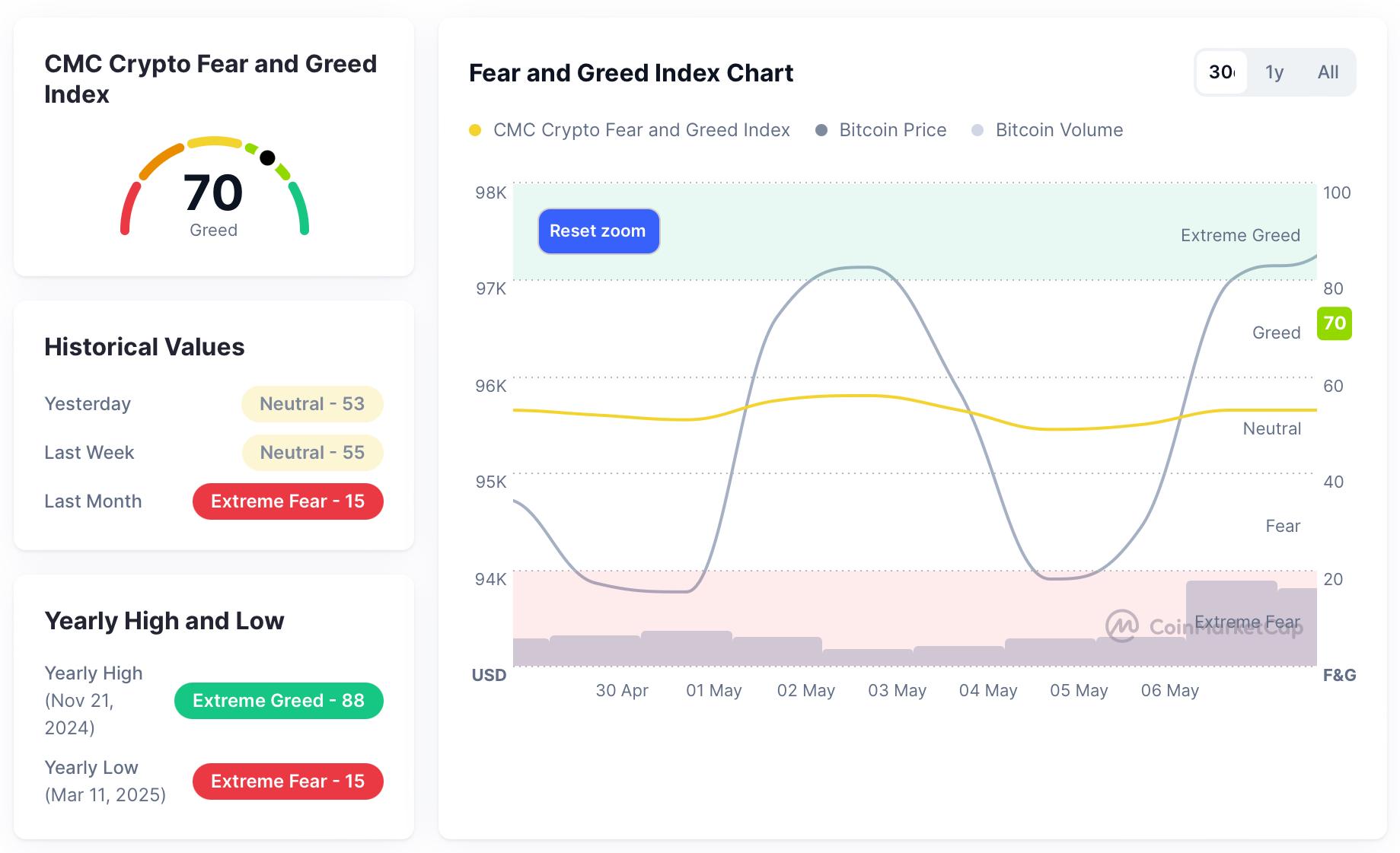
Fear and Greed Index Data Picture
Macroeconomic Background
1. Policy and geopolitical dynamics
US-China trade talks resume
The U.S. Treasury Secretary announced that he will hold talks with Chinese officials in Switzerland in an attempt to ease tense trade relations, boost market confidence, and drive up risky assets such as Bitcoin.
Trump administration strengthens encryption strategy
President Trump signed an executive order to launch the "Strategic Bitcoin Reserve" program to encourage states to reserve cryptocurrencies. New Hampshire took the lead in responding, allowing up to 5% of state reserves to be invested in Bitcoin, indicating the government's policy-friendly attitude towards crypto assets.
2. Federal Reserve policy and economic trends
Interest rates remain unchanged, policy remains on hold
On May 7, the Federal Reserve maintained the federal funds rate in the range of 4.25%-4.5%. Chairman Powell said he would wait for more data to assess changes in inflation and unemployment, and current policies will remain stable.
Signs of economic growth slowing down
The US GDP fell by 0.3% in the first quarter of 2025. Despite strong employment data, the uncertainty caused by high tariff policies is undermining business and consumer confidence, inhibiting investment and consumption.
3. Europe: Weak growth and divergent policies
Construction sector continues to shrink, German orders rebound
The construction industry in the UK and the Eurozone continued to decline, showing weakness in infrastructure and real estate. German factory orders grew by 3.6% month-on-month, bringing a glimmer of hope to the Eurozone economy.
Bank of England may cut interest rates to cope with pressure
Affected by the slowdown in global demand and spillover from US policies, the Bank of England is expected to cut interest rates by 25 basis points this month, sending a signal of easing to stimulate the economy.
4. Market summary and outlook
The global financial market continues to pay attention to Sino-US trade relations and the Fed's policies. US stocks rose slightly, while European stocks performed poorly due to economic data. The global economy faces triple pressure: US trade protectionism impacts the foreign trade environment, Europe's fundamentals are weak, and China is stabilizing growth with loose policies. Market volatility has increased, and investor sentiment has tended to be cautiously optimistic. It is necessary to pay close attention to policy trends and flexibly adjust allocation strategies.
3. Hash rate changes
From May 3 to May 9, 2025, the Bitcoin network hash rate fluctuated as follows:
On May 3, the hash rate of the entire network fell from 922.97 EH/s to 859.61 EH/s, and then began to fluctuate upward, rising to a maximum of 1077.53 EH/s during the day, showing some signs of recovery in computing power. On May 4, the overall hash rate showed a downward trend, continuing to drop from 1047.71 EH/s, with a minimum of 811.22 EH/s. The intraday fluctuations were large, which may be affected by miners' income pressure or energy costs. On May 5, the computing power fluctuations intensified, and the overall upward trend was maintained. The hash rates reached 926.05 EH/s, 1080.63 EH/s and 1095.40 EH/s respectively. Although they fell back to 974.24 EH/s halfway, they rebounded quickly, showing that the network has strong recovery capabilities. On May 6, the hash rate entered a correction cycle again, maintaining a downward trend throughout the day, falling from 1076.27 EH/s to 912.23 EH/s and 818.57 EH/s, reflecting that some miners or equipment temporarily withdrew from the network. On May 7, the hash rate first dropped to this week's low of 743.05 EH/s, and then gradually recovered to 910.84 EH/s, which may indicate that miners adjusted their deployment rhythm according to electricity prices and network difficulty. On May 8, the hash rate rose to a high of 963.39 EH/s, and then briefly pulled back to 907.12 EH/s, but climbed again on the same day, reaching a peak of 1061.27 EH/s. Since then, the hash rate has fallen back to 948.67 EH/s. As of May 9, the hash rate dropped slightly from 975.91 EH/s to 939.56 EH/s.
From the overall trend, the hash rate of the Bitcoin network has shown a wide range of fluctuations since the beginning of May 2025. During this period, the hash rate fluctuated greatly between about 743 EH/s and 1095 EH/s, indicating that the distribution of network computing power has been frequently adjusted in the short term. This phenomenon may be related to factors such as miners re-evaluating their profit models, changes in electricity costs, or fluctuations in power grids in North America and parts of Asia.
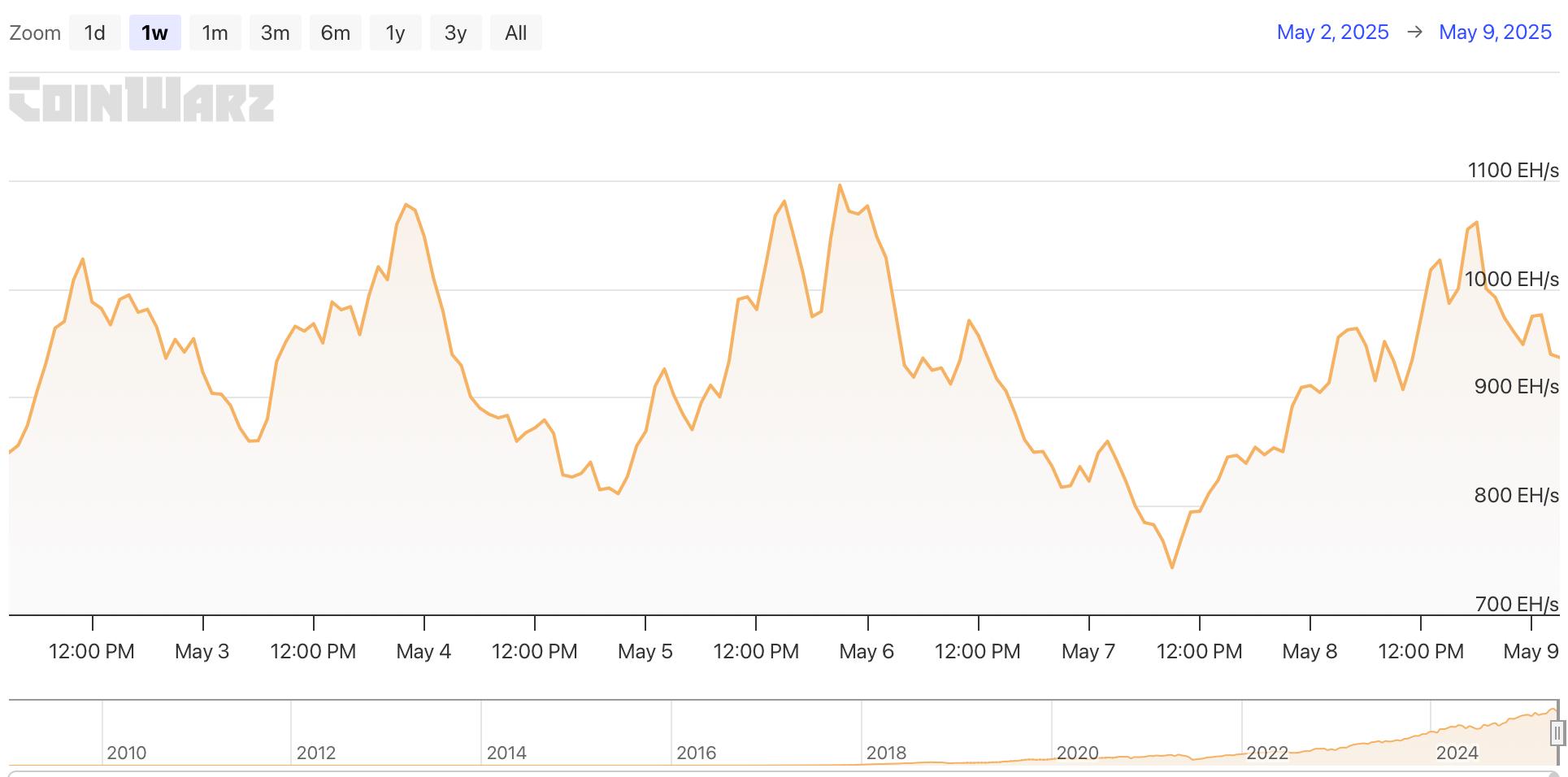
Bitcoin network hash rate data
4. Mining income
According to YCharts data, the total daily income of Bitcoin miners this week (including block rewards and transaction fees) is as follows: May 3: 50.4 million US dollars; May 4: 43.16 million US dollars; May 5: 52.29 million US dollars; May 6: 41.32 million US dollars; May 7: 46.40 million US dollars; May 8: 50.31 million US dollars. From the overall trend, the average daily total income of miners this week remained in the range of about 43 million to 52 million US dollars, showing mild fluctuations. Although there was a slight correction on some trading days, the overall performance was stable, indicating that the current network transaction activity is relatively high, and the fee income provides some support for miners' income.
From the perspective of unit computing power income, as of now, the Bitcoin hash price (Hashprice) is about $54.91 per PH/s/day, which has returned to a relatively high level in the past month. The continuous rise in Hashprice for several days reflects the stable market demand for computing power, and also benefits from the stabilization of Bitcoin spot prices and active trading activities.
The recovery of hash price will help improve the profit margin of miners, especially for mining farms with high operating efficiency and low unit electricity cost. In the current market environment, the improvement of computing power income may attract more miners to restore or expand computing resources, and promote further fluctuations in the hash rate of the whole network. In addition, the upward trend of Hashprice also indirectly indicates that some high-cost mining machines are still economically feasible to be put into operation in the current price range, which will support the return of computing power and network stability in the short term.
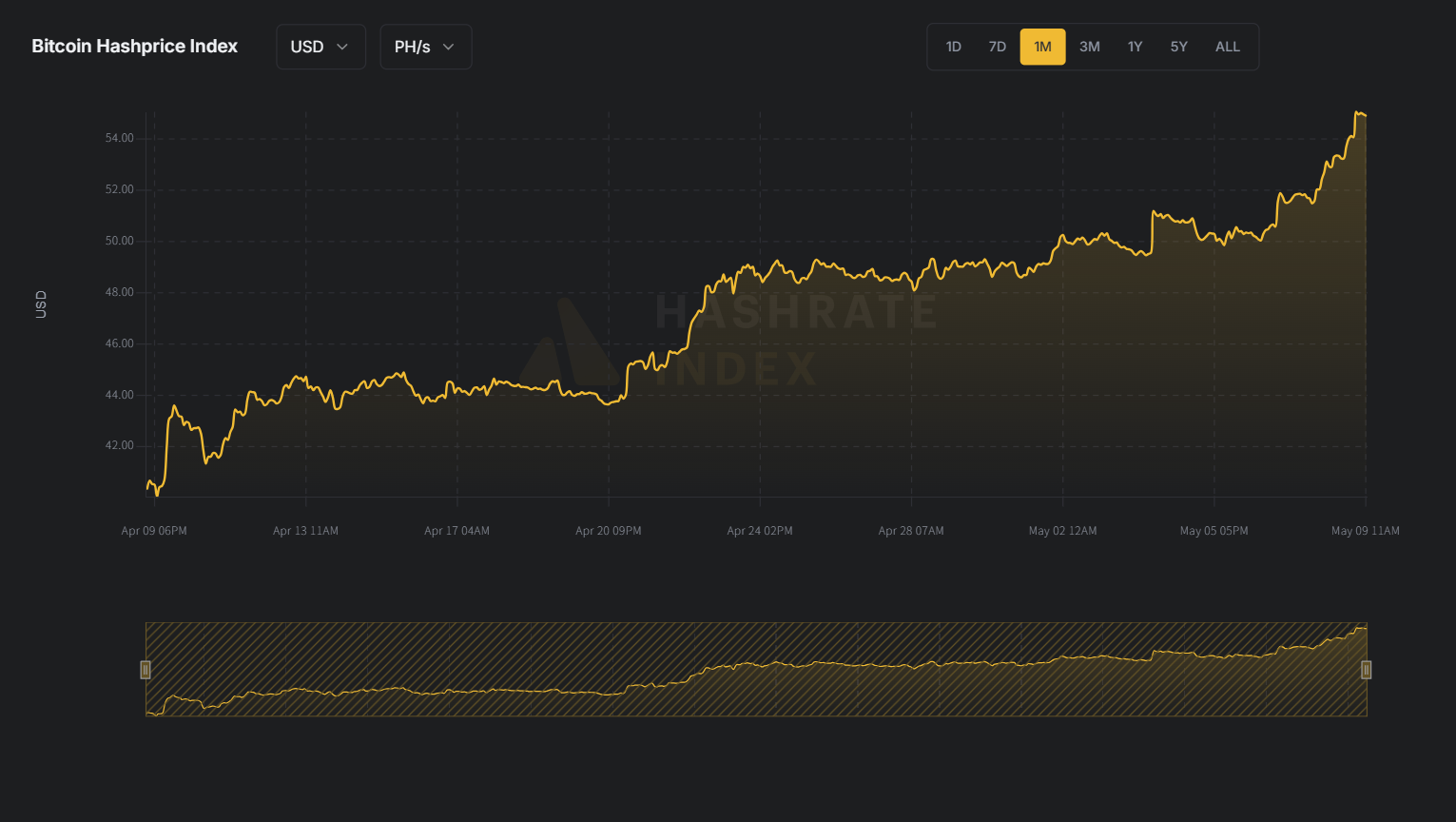
Hashprice data
5. Energy costs and mining efficiency
According to CloverPool data, the Bitcoin network has completed the latest difficulty adjustment at 05:00:13 on May 4, 2025 (block height 895,104), and the mining difficulty in this round has been reduced by 3.34% to 119.12 T. As of May 9, 2025, the total network computing power remains at about 921.50 EH/s, and the mining difficulty remains at 119.12 T. Combined with the current computing power trend, the next round of difficulty adjustment is expected to occur around May 17, and it is expected to increase by about 3.88% to 123.74 T. This trend shows that after a short-term computing power fluctuation, the overall computing power of the network is steadily recovering, and mining activities are gradually returning to a higher load level, reflecting the recovery of miners' participation and the enhancement of network processing capabilities.
From a cost perspective, according to MacroMicro's latest model, as of May 7, 2025, the unit production cost of Bitcoin is approximately $88,965.59, while the spot price during the same period is $97,032.32, and the corresponding mining cost-to-price ratio is 0.92. This ratio is slightly lower than 1, indicating that the current Bitcoin market price is still higher than the average mining cost, and most miners are in a profitable state, with economic incentives to continue to invest in computing resources.
Overall, the Bitcoin network is currently showing a clear recovery trend in terms of mining difficulty, computing power fluctuations and cost structure. The upward computing power, the expected increase in difficulty and the positive cost spread together constitute a positive signal for miners, further supporting the stable operation and decentralized security of the network. Overall, the Bitcoin network still shows good resilience and market responsiveness in the adaptation stage after the halving.

Bitcoin mining difficulty data
6. Policy and regulatory news
Florida Senate Withdraws Bitcoin Strategic Reserve Bill
On May 6, according to Cointelegraph, two Florida crypto bills have been removed from the legislative process, dealing the latest blow to the U.S. state-level strategic Bitcoin reserve goal. The Florida Senate said Florida House Bill 487 and Senate Bill 550 were "indefinitely postponed and withdrawn for consideration" on May 3. The Florida Legislative Assembly adjourned on May 2 without passing the two bills, which would have promoted legislation to establish cryptocurrency reserves in the state.
New Hampshire allows Bitcoin holdings up to 5% of state funds
On May 7, the Governor of New Hampshire signed HB 302, which adopts the Strategic Bitcoin Reserve (SBR) model of Satoshi Action. The content of HB 302:
- Allow state treasury to purchase Bitcoin and top digital assets - authorizes reserves to purchase up to $500 billion in Bitcoin (full stop loss only);
- Holding capped at 5% of total state funds – ensuring Bitcoin complements the state’s broader investments;
- Enforcement of US regulated custody - assets must be held by a state-controlled multisig or through a US exchange-traded product to maximize security and transparency;
-Effective 60 days after entry into force - Provides a clear operating framework for reserves and stacks.
Arizona Senate Approves Bitcoin Reserve Bill SB 1373, Sends It to Governor
On May 7, according to Bitcoin News, the Arizona Senate approved the Bitcoin Reserve Bill SB 1373 and sent it to Governor Katie Hobbs for final decision.
Earlier news, the governor of Arizona vetoed the state's strategic Bitcoin reserve bill SB 1025.
Texas Bitcoin Reserve Bill SB 21 passed the DOGE committee review, and the final result will be announced in the next three weeks
On May 8, according to Bitcoin Laws, the Texas Strategic Bitcoin Reserve Act (SB 21) has passed the DOGE Committee without amendments and will enter the final plenary voting stage. As the Texas legislature will adjourn on June 2, the final result of the bill is expected to be announced in the next three weeks.
The bill is an important legislative initiative for Texas to establish a strategic Bitcoin reserve. It has now completed all committee review procedures and is only one step away from final passage.
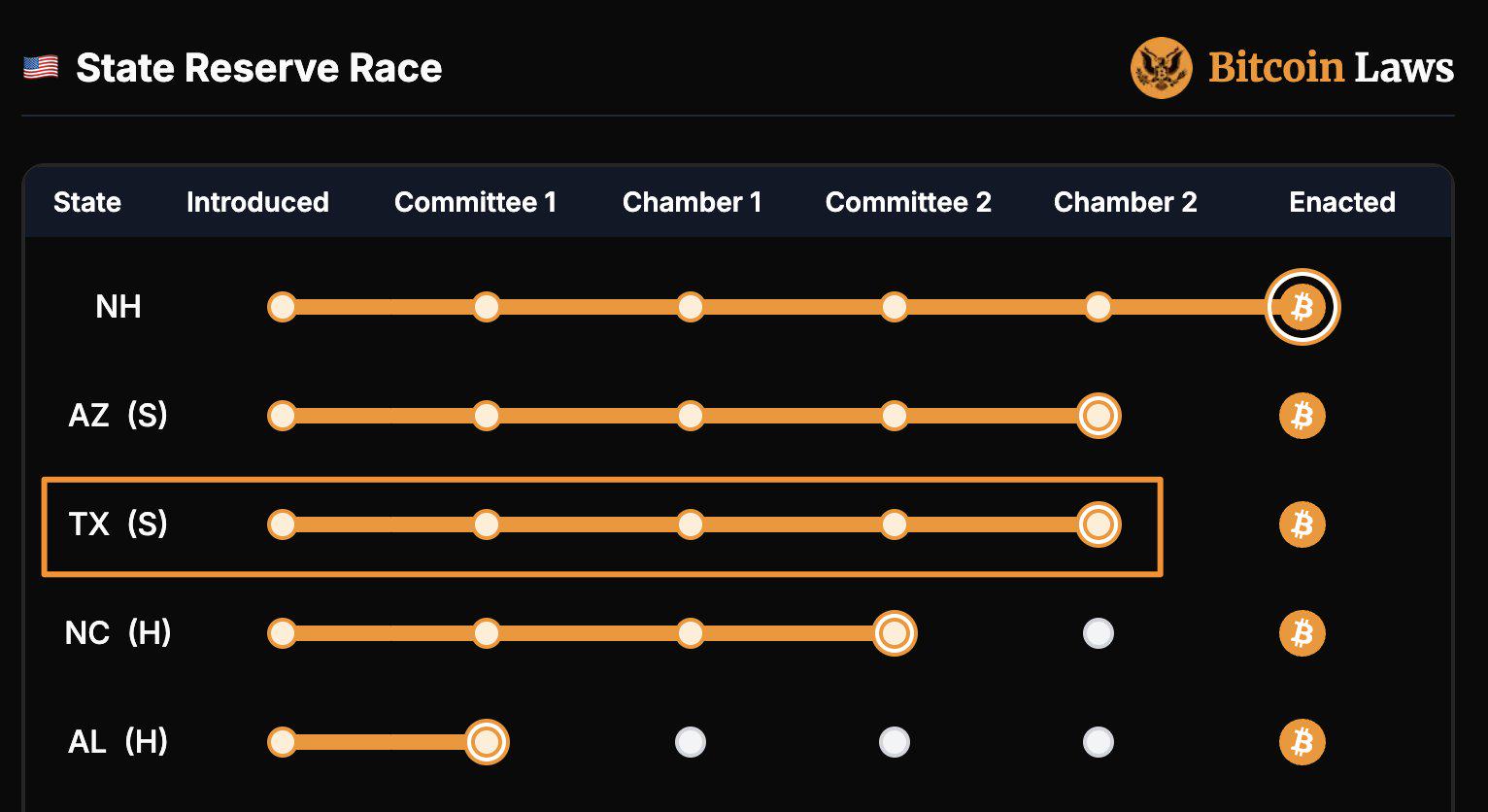
Related images
7. Mining News
Block: US-made Bitcoin mining chip Proto to be launched this year to cope with tariff risks
On May 2, Block CEO Jack Dorsey said that the company is manufacturing Bitcoin mining chips Proto in the United States to cope with rising tariffs and overseas manufacturing risks. The chip is scheduled to be launched in 2025, using open source design, emphasizing flexibility and direct cooperation with US suppliers. In addition, Block disclosed that it achieved a gross profit of US$2.29 billion in the first quarter, a year-on-year increase of 9%, of which Cash App's gross profit increased by 10% to US$1.38 billion, and Square's increased by 9% to US$898 million.
Lendn executive: Bitcoin miners should hold onto the Bitcoin they mine
On May 4, John Glover, chief investment officer of Bitcoin lending company Ledn, said that Bitcoin mining companies should hold the Bitcoin they mined and use it as collateral for legal loans to pay operating expenses, rather than selling Bitcoin and losing the upside of assets that miners expect to soar in price.
Glover said there are many benefits to holding BTC, including price appreciation, tax deferral, and earning additional income by lending out BTC held in corporate bonds.
Data: Last week, the purchase volume of US Bitcoin ETFs reached nearly 6 times the output of miners
According to data released by asset allocation platform HODL15Capital on May 5, spot Bitcoin ETFs listed in the United States purchased a total of about 18,644 Bitcoins in the past week. During the same period, considering the mining efficiency after the halving of Bitcoin (about 450 Bitcoins per day), global miners only produced about 3,150 Bitcoins in total. This means that the purchase volume of ETFs is almost 6 times the output of miners during the same period.

Related images
8. Bitcoin related news
Bitcoin holdings of global companies and countries (statistics for this week)
1. El Salvador purchased 1 additional bitcoin this week, and currently holds a total of 6,166.18 bitcoins, with a market value of approximately US$593 million.
2. Brown University disclosed that it holds approximately $5 million worth of BlackRock spot Bitcoin ETF, reflecting that university institutional funds are deploying Bitcoin assets.
3.Strategy (formerly MicroStrategy) increased its holdings of 1,895 bitcoins on May 1, investing approximately US$180.3 million. Its total holdings currently stand at 155,450 bitcoins, with a cost price of approximately US$68,550.
4. Semler Scientific increased its holdings of 167 bitcoins on May 2, with a total investment of US$16.2 million. Its current total holdings are 3,634 bitcoins, with a year-to-date return of 22.2%.
5. Australia's Monochrome's IBTC Bitcoin spot ETF holdings increased to 350 pieces, with a market value of approximately US$52.146 million.
6. BlackRock increased its holdings of Bitcoin worth $2.5 billion last week, equivalent to buying $500 million a day; in the past two weeks, it has accumulated 41,452 BTC through its iShares Bitcoin Trust ETF, with a total holding of 614,639, with a market value of approximately $58.07 billion. At the same time, its Q1 2025 report disclosed that Bitcoin-related stock assets have reached $5.43 billion, and IBIT ETF holdings have increased from 2.6 million shares to 5.85 million shares, and new positions have been established, such as Fidelity FBTC and Grayscale GBTC.
7. The listed company KULR increased its holdings of 42 bitcoins this week, bringing its total holdings to 716.2 bitcoins, worth approximately US$69 million. The return on investment has reached 197.5% since the beginning of the year.
8. Thumzup submitted an amendment to increase the financing limit from US$200 million to US$500 million to advance its Bitcoin acquisition strategy. The board of directors has authorized the use of up to 90% of its liquid assets to purchase Bitcoin.
9. Cango, a New York Stock Exchange-listed company, added 470 bitcoins in April, and its current total holdings rose to 2,944.8 bitcoins. The source of funds includes US$352 million from the sale of its auto finance business.
10. On May 2, Metaplanet, a Japanese listed company, increased its holdings of 555 bitcoins at an average price of approximately US$89,000, bringing its total holdings to 5,555 bitcoins, with a total investment of approximately US$465 million. At the same time, it announced the issuance of US$25 million in interest-free bonds to continue purchasing bitcoins in the future. The bonds will mature on November 6, 2025.
Fidelity: Bitcoin could surpass gold's dominance at any time
On May 4, Jurrien Timmer, global macro director of Fidelity Investments, analyzed the dynamics between Bitcoin and gold, pointing out that Bitcoin could surpass gold's dominance at any time. According to the change in the Sharpe ratio that measures the risk-adjusted returns of the two assets, gold and Bitcoin are negatively correlated with each other. Since Bitcoin's Sharpe ratio is -0.40 and gold's is 1.33, this means that Bitcoin may lead the market next and we will see the baton pass from gold to Bitcoin. Jurrien Timmer suggested to investors that the starting portfolio is four parts of gold to one part of Bitcoin, because the volatility of gold is only one-fourth of Bitcoin, although they have similar Sharpe ratios.
Viewpoint: When capital flows into the crypto space, it will inevitably flow into Bitcoin. 1.5% of personal investment portfolios have been allocated to BTC
On May 4, well-known investor Kevin O'Leary pointed out that institutions are reluctant to touch Ethereum at this stage. When a large amount of capital flows into the cryptocurrency field, it will inevitably flow to the flagship digital asset: Bitcoin. In particular, Bitcoin has recently decoupled from traditional stock indexes. This is an important development, indicating that this asset is maturing into a unique investment category, and is even on par with gold as a means of hedging and value storage. In addition, Kevin O'Leary also disclosed that he has allocated 1.5% of his portfolio to Bitcoin and 19% to other areas involving cryptocurrencies, including the purchase of Coinbase and Robinhood stocks.

Related images
Coinbase Investor: Bitcoin Could Be Worth ‘Infinite’ Dollars
On May 5, Coinbase investor Tim Draper posted on the X platform that the value of Bitcoin may reach an "unlimited" amount of dollars, which sounded the alarm for the collapse of legal trust, the historic weakness of the dollar, and the acceleration of the dominance of cryptocurrencies. Tim Draper explained that during the Civil War, the Confederate silver dollar experienced hyperinflation, and by the end of the war, the ratio of the Confederate silver dollar to the dollar plummeted to more than 10 million to 1. As trust declined, people rushed to exchange it for dollars. Now that the US dollar index has started the year with the worst performance in 40 years, market confidence in the dollar may decline further, and the United States is hedging this situation by incorporating Bitcoin into its strategic reserves.
QCP: Macroeconomic data reflects resilience, and stable inflows into Bitcoin ETFs indicate continued institutional demand
On May 5, QCP Capital released a market analysis pointing out that the macro data released last Friday provided a nuanced snapshot of the US economy, with non-farm payrolls increasing by 177,000, exceeding expectations of 133,000, and the unemployment rate stabilizing at 4.2%. However, behind the strong data, economists continue to warn that the full economic impact of the recent tariffs has not yet emerged, and the market is cautiously optimistic about this. At the same time, the market generally expects the Federal Reserve to keep interest rates unchanged at this week's policy meeting. Despite a record loss in the first quarter, Strategy has doubled its financing target to $84 billion. The loss was caused by the adoption of new digital asset market price accounting standards. This latest move highlights the company's firm belief in its long-term Bitcoin strategy. At the same time, the steady inflow of spot Bitcoin ETFs indicates that institutional demand continues to exist and reinforces the growing role of the asset in a diversified portfolio.
Forbes: Wall Street institutions are preparing for a sharp rise in Bitcoin and cryptocurrency markets
On May 6, according to anonymous sources, high-speed trading giant Tower Research Capital has joined Citadel Securities to "increase its bets on cryptocurrencies." As the Trump administration promises to open up Bitcoin trading and cryptocurrency markets, lift Biden-era restrictions, and quickly advance legislation to reshape the financial system, Wall Street is quietly increasing its support for Bitcoin and cryptocurrencies.
Last week, Wall Street giants, which manage a combined $10 trillion on behalf of clients, predicted they would “open up for business” with bitcoin this year, allowing advisers to recommend bitcoin ETFs to clients for the first time.

Related images
K33 analyst: Bitcoin market may break the "May decline effect", supported by Trump-related positive factors
On May 7, according to The Block, analysts from the cryptocurrency research institution K33 said that investors should continue to hold Bitcoin in May, which is contrary to the traditional "sell in May" strategy.
Analysts believe that despite the critical deadline of the Strategic Bitcoin Reserve having passed and no public announcement, the market situation will be different in 2025. Multiple Trump-related positive factors are expected to drive the market, which may prevent the market performance from the usual downturn in previous years this summer.
Bitcoin Magazine CEO: Bitcoin is accelerating its transformation into a global reserve asset
According to The Block on May 8, Bitcoin Magazine CEO David Bailey said that Bitcoin is transforming into a global reserve asset at a faster rate than expected. Bailey emphasized that as the adoption rate at the national level increases, Bitcoin has gradually evolved from an early rebellious technology to a strategic consideration at the national security level. He particularly pointed out that the accelerated institutionalization process and the continued investment of institutions such as Strategy (formerly MicroStrategy) are driving a clear differentiation between Bitcoin and the broad cryptocurrency market.
Bitcoin's market value surpasses Amazon and rises to fifth place in global assets
On May 9, according to 8Marketcap data, Bitcoin’s current market value is 2.045 trillion US dollars, surpassing Amazon to rise to fifth place in the global asset rankings.














